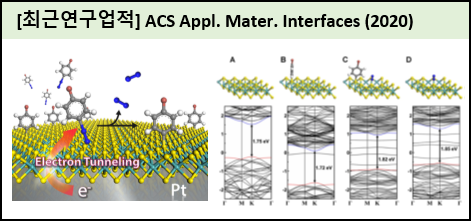|
Title |
Tunable optical transition in 2H-MoS2 via direct electrochemical engineering of vacancy defect and surface S-C bonds |
|
Author list |
Park, Younghee Park; Shin, Seunghyun; An, Youngjoon; Ahn, Jong-Guk; Shin, Geumbi; Ahn, Chaehyeon; Bang, Jiwon; Baik, Jaeyoon; Kim, Yousoo; Jung, Jaehoon*; Lim, Hyunseob Lim* |
|
Publication date |
2020/09 |
|
Citation information |
ACS Applied Materials & Interfaces, 12, 40870 (2020) |
|
DOI |
10.1021/acsami.0c09096 |
|
Graphical Abstract |

|
|
Abstract |
Although surface engineering has been regarded to be a great approach to modulate the optical and electrical properties of nanomaterials, the spontaneous covalent functionalization on semiconducting 2H-MoS2 is a notoriously difficult process, while several reactions have been performed on metallic 1T-MoS2. This limitation in functionalization is attributed to the difficulty of electron transfer from 2H-TMD to the reacting molecules due to its semiconducting property and neutral charge state. Unfortunately, this is an all too important prerequisite step toward creating chemically reactive radical species for surface functionalization reactions. Herein, an electrochemical approach was developed for facilitating direct surface functionalization of 2H-MoS2 with 4-bromobenzene diazonium tetraborate (4-BBDT). Successful functionalization was characterized using various microscopic and spectroscopic analyses. During the course of investigating the change of optical transition seen for modified 2H-MoS2 using photoluminescence measurement combined with theoretical calculations, our study uncovered that the controlling S-C bond and sulfur vacancy generation could tune the electronic structure of functionalized 2H-MoS2. |
|

